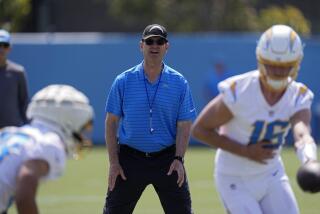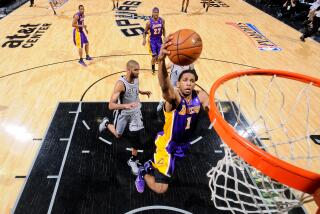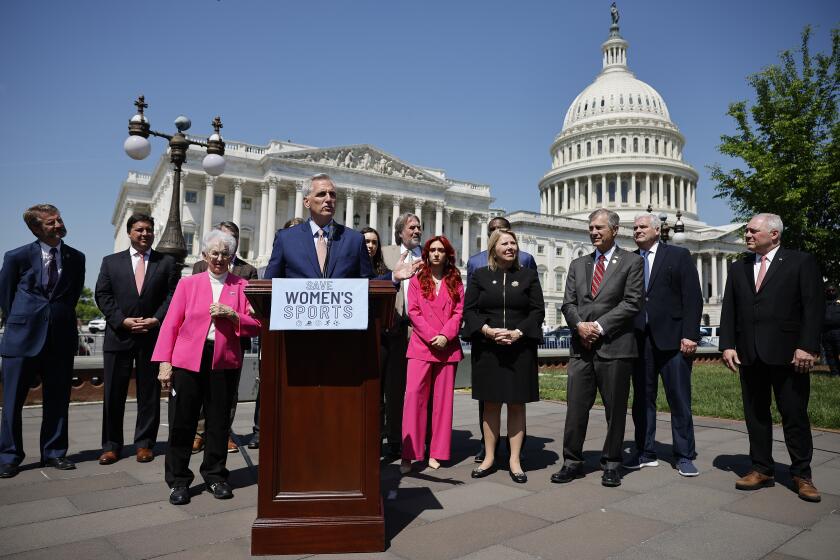Voters Have Shown Some Four-Sight
With the unusual and notable exceptions of Brett Favre and Adam Vinatieri, the number 4 is nothing to brag about in the NFL.
“We’re No. 4!” Congratulations, you just lost the conference championship game.
“We’re down by four.” A field goal can’t save you now.
Fourth place? In the realigned NFL, that means last place.
Fourth down? Time to punt.
Fourth quarter? Time’s running out.
Fourth string? “Son, Coach wants to see you. And bring your playbook.”
But fourth in the annual Heisman Trophy voting?
Well done. You’re on your way to a prosperous NFL career.
Over the last decade, this is what the Heisman Trophy has become:
First place usually goes to the best publicized quarterback from a Florida school or the best publicized running back from a Midwestern school.
Second place usually goes to a scrambling quarterback who will probably be playing another position, or finding another line of work, within three years.
Third place usually goes to another quarterback, whose college career peaked too soon or too late for the Heisman voters to notice.
Fourth place usually goes to the player with big upside and big-league potential, held back mainly by geography and/or position and/or an undermanned publicity department.
Consider the previous 10 Heisman elections (and NFL general managers please note: Miami’s Willis McGahee finished fourth in the 2002 balloting):
*
2001
Winner: Eric Crouch.
Fourth place: Joey Harrington.
Crouch was drafted by the defending NFC champion St. Louis Rams. Harrington was drafted by the Detroit Lions. Guess who took a quick look around, gulped and immediately retired.
Predictably, Harrington has taken a pounding in his first season with the Lions, looking very much the embattled rookie at times. He has the lowest completion percentage (50.2) and quarterback rating (60.0) among NFL qualifiers, but he’s still feeling his way, learning every week. He managed to oversee three Detroit victories and send three other games into overtime.
*
2000
Winner: Chris Weinke.
Fourth place: LaDainian Tomlinson.
While Weinke was losing the Carolina quarterback job to 36-year-old Rodney Peete, Tomlinson established himself as the greatest single-season rusher in San Diego Charger history. After 13 games, he ranks third in the NFL, behind Ricky Williams and Priest Holmes, with 1,375 yards rushing, averaging 4.5 yards a carry. He’s also San Diego’s leading pass catcher, with 64 receptions for 432 yards, and the primary reason the Chargers remain in playoff contention at 8-5.
*
1999
Winner: Ron Dayne.
Fourth place: Drew Brees.
Dayne has had a good seat watching Giant teammate Tiki Barber rush for 1,000-plus yards in two of the last three seasons. Brees is the quarterback the Chargers drafted after trading away the pick that became Michael Vick. Brees was taken in the second round after the Chargers had already selected their franchise running back, Tomlinson, in the first.
Would the Chargers have been better off with Vick, but without Tomlinson? Doubtful. In his first season as San Diego’s full-time starter, Brees has been efficient, if not spectacular. But after Ryan Leaf, all the Chargers were hoping for was A) upright, B) semifunctional and C) noncontroversial. Vick, who’d have been the ultimate round peg in Marty Schottenheimer’s resolutely square offensive system, could not have guaranteed that last bit.
*
1998
Winner: Ricky Williams.
Fourth place: Tim Couch.
For once, the Heisman voters projected it right -- although it took Williams a trade to Miami and a breakthrough fourth season to finally convince the doubters. Couch bears the scars of growing up in the NFL on an expansion team -- no offensive line in the early going, costing him more than half the 2000 season, and no running game for his first 3 1/2seasons, stranding him in an easy-to-defend-against game plan.
In Season 4, he has the Browns on the fringes of the playoff race, with rookie running back William Green’s late-season development finally lightening his load.
*
1997
Winner: Charles Woodson.
Fourth place: Randy Moss.
Woodson has played in three Pro Bowls and maybe a Super Bowl is next, if the Raiders can secure home-field advantage through January. Moss is Moss -- the most formidable game-breaker in the league during those moments when he’s interested, a franchise-breaker when he’s not. So what is it with the 2001 and ’02 Vikings? Have they not won enough to maintain Moss’ attention? Or has Moss been too uninterested for the Vikings to win enough?
*
1996
Winner: Danny Wuerffel.
Fourth place: Orlando Pace.
Wuerffel is the No. 3 starter in Steve “Captain Hook” Spurrier’s three-man Redskin pitching rotation. Pace, being an offensive lineman, never had a prayer in the Heisman voting. But he has played in two Pro Bowls, and you saw what happened to the Rams’ offense once injuries knocked him out of the lineup.
*
1995
Winner: Eddie George.
Fourth place: Darnell Autry.
A career year for the Heisman voters.
*
1994
Winner: Rashaan Salaam.
Fourth place: Kerry Collins.
Salaam rushed for 1,074 yards in his rookie season, 610 in three seasons after that. Collins, after troubled stints in Carolina and New Orleans, pulled his act together in New York. The Giants won a conference championship in 2000 and Collins surpassed the 20,000-yard passing mark this season.
*
1993
Winner: Charlie Ward.
Fourth place: Marshall Faulk.
Ward was Heisman’s great gift to the NBA, for whatever that has been worth. Faulk, the greatest NFL all-purpose back of his era, was hopelessly handicapped in the major-college-heavy, East Coast-biased ’93 Heisman balloting. He played for San Diego State.
*
1992
Winner: Gino Torretta.
Fourth place: Marvin Jones.
Torretta’s syndrome -- a condition commonly associated with Heisman Trophy winners who soon lose their way upon entry into the NFL. Jones has been a solid performer at inside linebacker in his decade with the New York Jets.
More to Read
Get our high school sports newsletter
Prep Rally is devoted to the SoCal high school sports experience, bringing you scores, stories and a behind-the-scenes look at what makes prep sports so popular.
You may occasionally receive promotional content from the Los Angeles Times.






